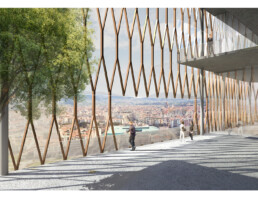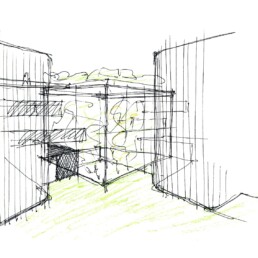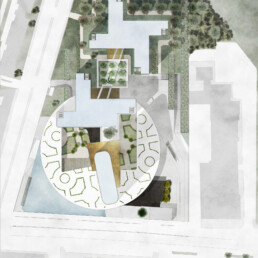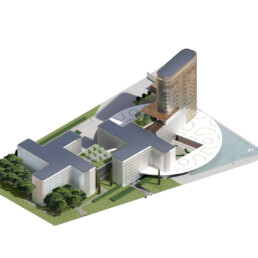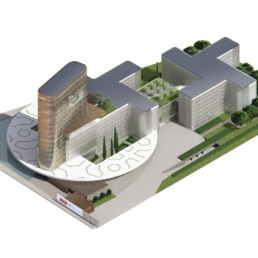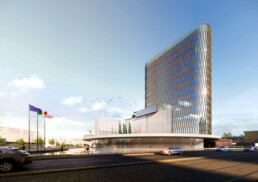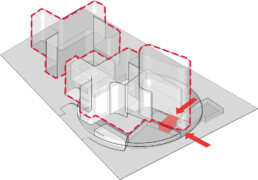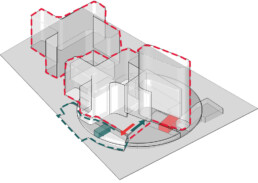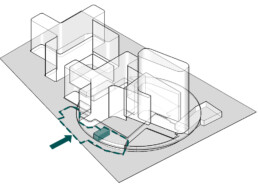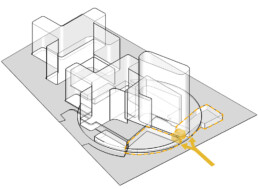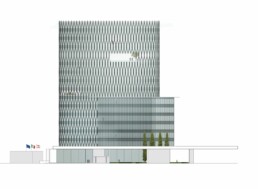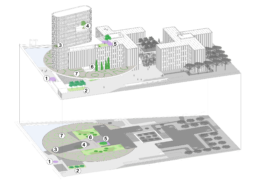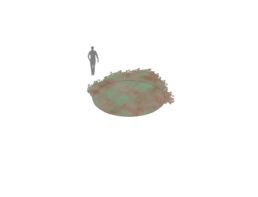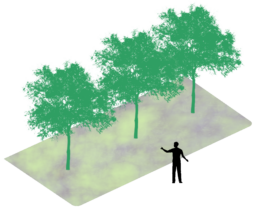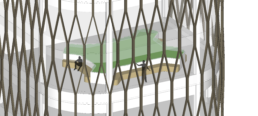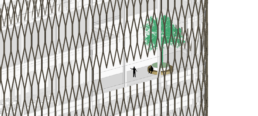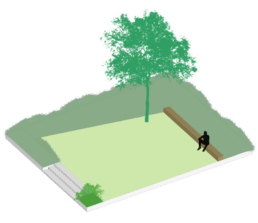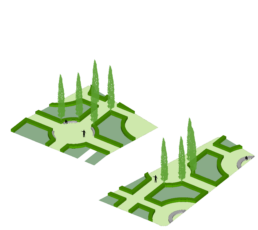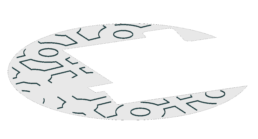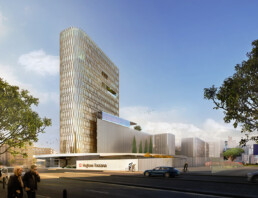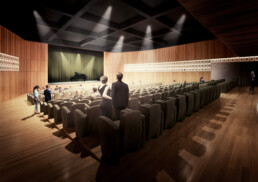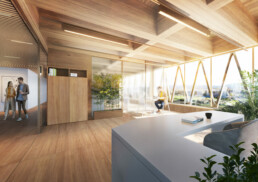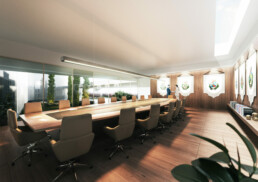THIRD TOWER TUSCANY REGION
competition
At the basis of everything is the idea of creating, in a future perspective, a composite and unitary organism made up of both the pre-existing structures and the new tower, bearer of a new identity, defined and yet fluid, but not derived from the simple sum of different components.
The various elements come together and integrate through a language mainly constituted by the interpretation and integration with the greenery present both in the new landscape of the project area and integrated as a constituent element, in the courtyards, in the terraces, in the large greenhouse which acts as a magical connecting ring of towers 1 and 2, in the large loggia facing towards the center on the 12th floor.
The architecture is expressed in a language consisting of the soft shapes of the surfaces, with the use of materials that are sensitive to light and its variations, which cover the façades of the existing buildings and which are transformed and joined together, enhancing the totally new texture and architecture of the third tower.
The Basement
a large and thick plate, circular, powerful yet light, jutting out towards Via della Toscana, forms the strong and transparent base on which Tower 1 and the Third Tower are grafted, emphasising the meeting point and connection between the city (the capital) and its regional administrative centre. Seen from above, from the offices but also in the now customary first view of the site, via Google Map, the plate, finished with a white photocatalytic cement screed and with the formal garden, appears as a grandiose element, inlaid with ground cover essences that will ideally follow the design pattern of the inner courtyards on the level below, essences modelled on designs inspired by the classical themes of Renaissance courtyards and gardens.
The deep loggia overhangs the thin sheet of water that multiplies the wide, curved glass wall. Cleanliness, transparency, openness, future projections framing one of the two main entrances to the complex, the direct one from the street and the tramway that connects both with the administrative functions of the complex and, independently, with the spaces that are independently accessible and open to the city, for example the auditorium.
The Existing
The two existing towers will be visually connected, softened and contained by enclosures with fluid lines, both in terms of the surface pattern and the shape of the constituent elements. It will be a ‘skin’ with a vibrant canneté effect, consisting of tall cylindrical rods with a diameter of 20 cm, made of opalescent and completely recyclable fibreglass, with a slightly amber colouring. It will be a sort of cloak, with a consistency that is now almost compact, now transparent, allowing natural light to pass inwards and artificial light to pass outwards, with the possible creation of soft, vibrant night-time lighting scenarios. Immediately behind the external fifth (cylinders of fibreglass) we find an articulated steel structure that will have both the function of seismic adaptation of the building and that of load-bearing structure for the fifth, which, coupled with a glass wall for the entire extension of the existing façades, will have the function of providing an important improvement in thermal insulation. In fact, a continuous cavity will be created between the glazed surface and the existing façades, of variable depth 80/120cm (to be used also for plant passages and maintenance paths).
VIEW OF VIALE TOSCANA
VIEW OF VIA DI NOVOLI
The Third Tower
The new ‘skin’ enveloping Tower 1 extends in an embrace from which the new tower emerges, rising up to 61 m, consisting of eleven office levels and two, at the top, dedicated to plant and water storage, in addition to the two organised under the large plate. The plan of the operational levels is designed to be as free and flexible as possible. In fact, the basic structural mesh consists of a simple score of perimeter pillars and the nucleus of the vertical connections, while the function of upwind is partially fulfilled by an external system of “brise soleil”, in a giant order, juxtaposed to the glazing, a system consisting of structural steel mesh (with an external aluminium finish in a light bronze colour).
Function and decoration combine in a language that is both contemporary but also freely inspired by the decorative colours of tradition, the marble ribs of façades or the dynamic ribbing of modernism.
Accessibility and internal access controls
The large, thick plate that houses the ground floor is the main access point to the New Tower complex and the two existing towers.
On this, two large entrance points allow access to the business centre through identification and control by recognition systems such as automatic turnstiles. To facilitate further control, a concierge with a dedicated security service is also located near the two entrances.
For all the activities that will take place at the same time or even outside the working hours of the Region’s offices, such as the auditorium and its spaces, separate and independent entrances have been appropriately designed.
ACCESS CONTROL
STRUCTURE CONNECTION
OPERATIONAL
OPERATIONAL STRUCTURE
REGIONAL
FREE ACCESS
ELEVATION OF THE THIRD TOWER
Philosophy of the idea
The landscape project redevelops and integrates the existing open spaces to offer workers and citizens a symbolic collection of the iconic landscapes of the Region of Tuscany. Each green space outlined by the architectural design is an opportunity to evoke, through appropriate formal solutions and plant associations, a landscape shaped by the action of man over time, by culture, art, and the desire to know and share.
The design of each area mediates between the landscape to which it refers and the urban context in which it is set, through the use of clear lines, appreciable even from the top of the three Towers, and vegetation choices guided by the containment of maintenance operations. Just as in the Tuscan landscape nothing is left to chance or wasted, so the lot is articulated in clearly identified and recognisable green spaces, which participate with the architecture in the identity of the place.
1.MAIN ENTRANCE
Reference: the shrubs at the hillside.
A flower bed of dogwoods (Cornus sanguinea), a low-maintenance ornamental species, interesting even in winter for the colour of the stems.
2.FLOWER BED
Reference: cultivations.
Three mimosas (Acacia dealbata) with light foliage, a bed of Tuscan irises (Iris germanica var. fiorentina) and native meadow. Flowers and nectar for pollinating insects already in late winter.
3. COVERED TERRACE
Reference: belvedere
A container with Aralia (Fatsia japonica) and Pythosophorus (Pittosporum tobira), rustic evergreen, cool and sinuously shaped species.
A wooden seat around the green pool.
4. SECRET GARDEN
Reference: climate change.
A potted camphor tree (Cinnamomum camphora), an exotic species that is spreading from an ornamental rarity to Italy as a result of climate change. Around the perimeter of the circular container a seat welcomes visitors.
5. ROOF GARDEN
Reference: the Mediterranean scrub.
A holm oak (Quercus i/ex) and an aromatic flowerbed of shrubs and suffrutics suitable for positions exposed to the sun and winds. Only reorganization and rejuvenation pruning as needed. A long session at the bottom of the lawn.
6. FORMAL GARDEN
Reference: the historic gardens of Tuscany. Cypresses (Cupressus sempervirens ‘Stricta’), topiary boxwoods (Buxus balearica) and ivy (Hedera colchica): ease of management thanks to their small size and regular spaces. Stone furnishings with a shape consistent with the geometry of the spaces.
7. NATURAL GARDEN
Reference: historic gardens and sustainability. Extension of the formal garden (3) to cover the plate with rustic, perennial herbaceous plants, which will rewrite the green texture over time. Maintenance limited to tidying up pruning.
The entire study of the internal layout of the different rooms required, is based on the respect of the main criteria that allow an easy use and accessibility within the reach of all the users living in the new structure. In order to be able to respond to a possible request for modularity of the structure over time and adaptability of the interior spaces, the solution of a point-type load-bearing structure was used, so as to have the possibility of choosing between very divided and strict spaces or open-space spaces without any internal partitions.
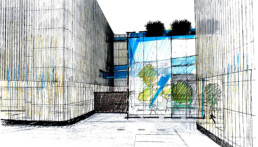
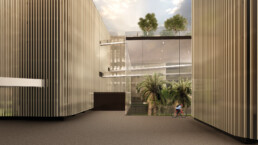
The focus was mainly on workstation environments, in compliance with the regulatory requirements of the current law regarding the protection and health of workers. The distributional hypothesis of the different office cores to be included in the new building refers to the explicit requirements indicated in the call for tenders and the number of workstations to be achieved. All office spaces and annexes are easily accessible from the main entrance on the ground floor via a system of vertical connections leading up to the top floor of the third tower.
In order to leave as much space as possible for gardens and liveability on the ground floor, a connecting path was created between the three towers at basement level -1. The pedestrian ramp, which leads from the new entrance of the third tower on the ground floor to the basement level, guides the user to the first tower, crosses the greenhouse housing the cycadales and palm collections of the Giardino dei Semplici, and leads to the second tower to the north.

 IT
IT